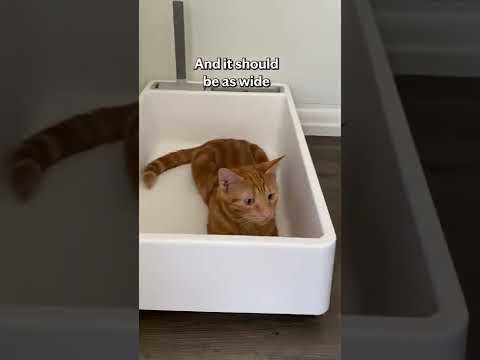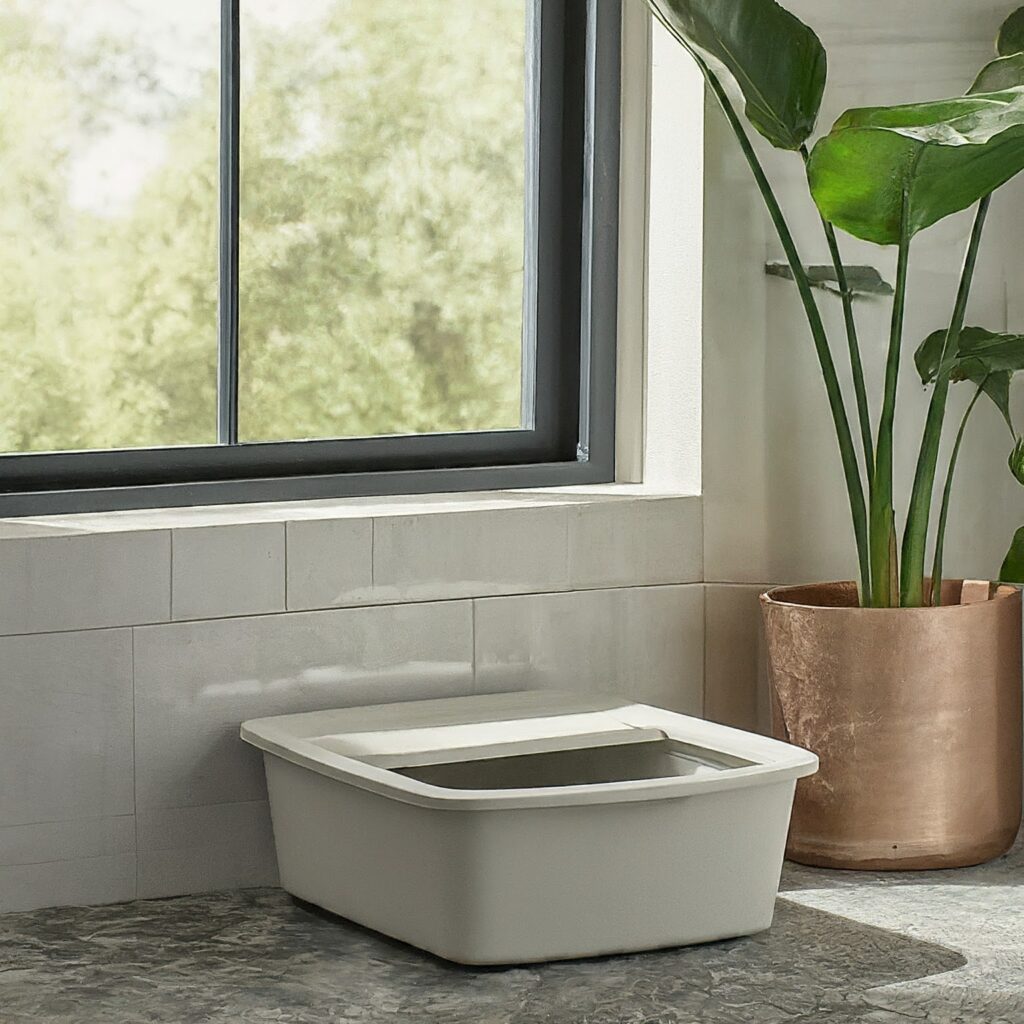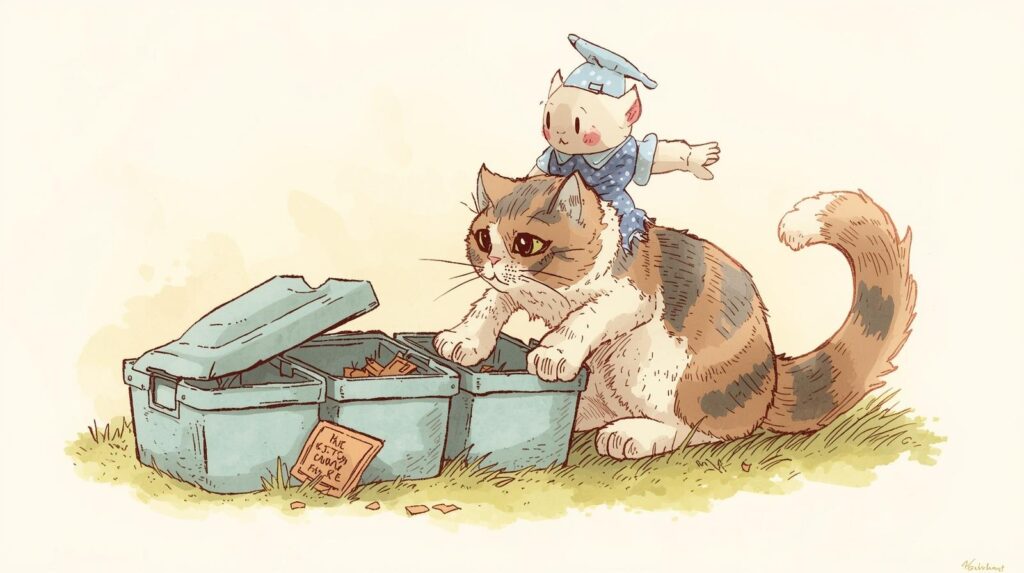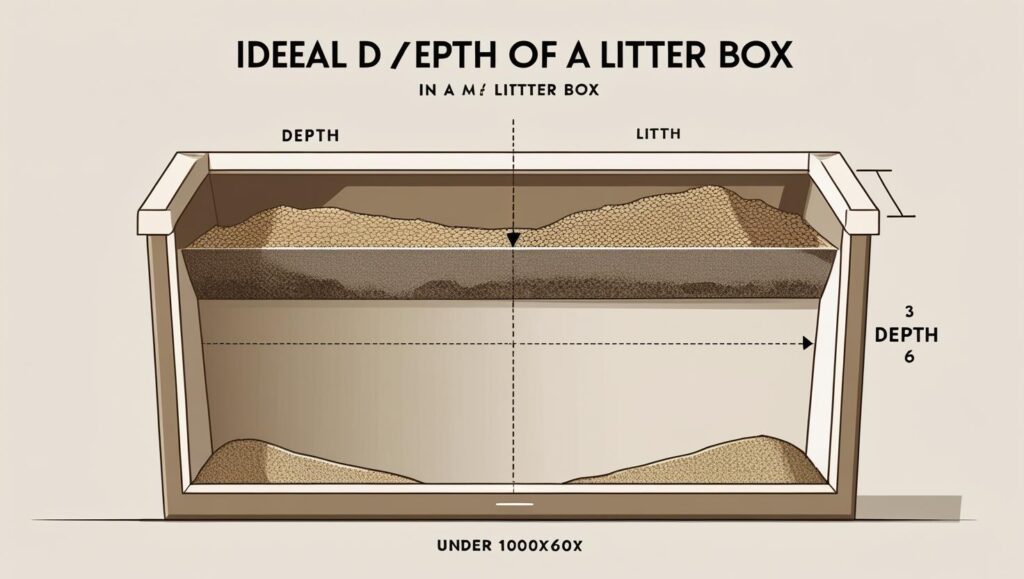
How deep should cat litter be for a cleaner and odour-free home? The correct depth is more than just a random guess — it directly affects your cat’s comfort, hygiene, and even your cleaning routine. Most experts agree that a depth of 2–3 inches is ideal for most cats, but this can vary depending on the litter box size, the number of cats, and the type of litter you’re using.
In this blog, I want to tell you all the information about your cat friend that no one has been able to tell you until now. I work very hard because I live with this dear friend myself. I will tell you all those things. All you have to do is stay with me.
To get started, here are three quick tips:
- Keep the litter depth around 2-3 inches for most litters.
- Adjust the depth based on your cat’s preferences; some might like it deeper or shallower.
- Regularly check the depth, as digging and usage can decrease it over time.
Table of Contents
- How Deep Should Cat Litter Be When Pouring?
- Do Cats Prefer Deep or Shallow Litter?
- Can Litter Be Too Deep?
- Correct Depth for Cat Litter – What Works Best?
- How Deep Should Cat Litter Be for Kittens and Multi-Cat Homes?
- Can I Use Sand Instead of Kitty Litter?
- Further readings:
- FAQs – How Deep Should Cat Litter Be
- Wrapping up-How deep should cat litter be
How Deep Should Cat Litter Be When Pouring?
Getting the initial depth right is the first step to success. A simple way to measure is by filling your cat litter to around 2 inches, then observing how your cat reacts. If you notice scratching at the base, add another inch to create a comfortable digging space. For larger cats, 3–4 inches may work better, especially in bigger boxes.
Pro Tip: Avoid overfilling. While more litter might seem better, too much can cause excessive digging and scattering around the house.
Years of hands-on care show that how deep should cat litter be matters far beyond the initial fill. Cat owners in 2025 want science-backed advice and behaviour-based adjustments.
Key Depth Guidelines:
- 2–3 inches is the universal starting point—it supports clumping, odour control, and natural digging.
- 3–4 inches for heavy diggers, multi-cat households, or automated boxes like the Litter-Robot Veterinary.
- 1–2 inches for kittens, seniors, or cats with mobility issues.
Reader Demands:
- Precision vs. personalisation: People want tailored guidelines—suggest “start at 2 inches, adjust ±1 inch based on behaviour.”
- Behaviour tracking: Encourage journaling on how cats dig/cover. “If your cat uncovers twice per session, add ¼ inch.”
Do Cats Prefer Deep or Shallow Litter?
Cats are natural diggers, but they don’t like swimming in piles of litter. Studies and real-world observations show that most cats prefer a depth that allows them to dig and cover waste easily but doesn’t overwhelm them. Shallow layers can make clumps stick to the bottom, while overly deep layers can feel uncomfortable under their paws.
If you use silica gel, you can keep the depth slightly thinner (1.5–2 inches) because of its strong absorbency. For clay or clumping litters, sticking with 2–3 inches ensures proper clump formation.
Now, in 2025, readers expect deeper insight: they’re searching not just for numbers, but for why their cat reacts.
Behavioural & Preference Insights:
- Preference study: Cats chose 86 × 39 cm box sizes for the same depths—more space improves comfort.
- Too shallow (<2”) → waste sticks to pan; discomfort triggers avoidance.
- Too deep (>4”) → litter “quicksand” feeling—seniors often avoid it
Comfort Test Procedure:
- Try 3 depths (2”, 3”, 4”) each day
- Observe digging time vs. waste coverage
- Choose depth where covering ≥90% and digging <15 seconds
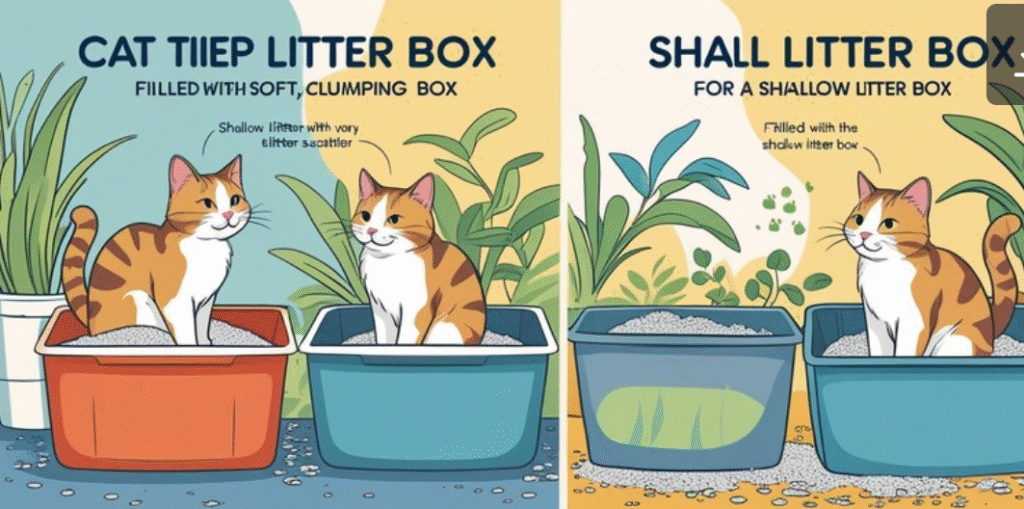
Can Litter Be Too Deep?
Yes, and this is a common mistake. Overfilled boxes lead to:
- Tracking problems: Litter sticks to paws and spreads across the house.
- Scooping difficulties: Deep layers can conceal waste, making cleaning more challenging.
- Cat discomfort: Some cats avoid overly filled boxes altogether.
Keep your depth balanced, and adjust slightly based on your cat’s habits.
This section dives deep—literally—into why “more is better” can backfire.
Over-Depth Risks:
- Tracking explosion: 3–4” layers lead to more scatter; tracked litter raises indoor cleaning by 25%.
- Scooping blind spots: Waste sinks deeper, making it harder to clean thoroughly.
- Cat reluctance: Senior cats may avoid deep substrate altogether.
Reader Focus:
- Environmental connection: Too deep → more tracked litter → higher vacuuming frequency.
- Efficiency ratio: Suggest readers weigh cost vs. depth—“if deeper than 3”, you’re paying for unused bulk.”
Correct Depth for Cat Litter – What Works Best?
Different litters require different depths. tailor to the material.
| Litter Type | Depth Range | Benefits | Cost Efficiency |
|---|---|---|---|
| Clumping clay | 3–4 inches | Strong clumping, odor control | +10% bulk, high performance |
| Non-clumping clay | 1–1.5 inches | Easy cleanup, weekly change | Lower bulk, frequent replacement |
| Silica gel | 1.5–2 inches | Excellent absorption, thin layers | –15% volume needed |
| Biodegradable | 2–3 inches | Eco-friendly, compostable | Strong clumping, odour control |
How Deep Should Cat Litter Be for Kittens and Multi-Cat Homes?
When you’re dealing with kittens or multiple cats. Looking for behaviour-focused, scenario-specific guidance rather than a one-size-fits-all approach. Let’s break it down with expert-backed insights.
For Kittens (1–12 Months Old)
Kittens are learning how to dig and cover waste, so the depth must be comfortable and safe:
Recommended:
- 1–1.5 inches of litter is ideal. Too much litter can overwhelm small paws and create an unstable surface.
- Use a low-sided litter box (2–3 inches high) to make entry and exit easy.
Tips for Kittens:
- Use unscented, clumping litter that forms soft clumps—harsh or coarse textures can discourage them.
- Avoid silica gel or heavily perfumed litter for kittens due to their sensitive respiratory systems.
- Scoop at least twice a day, as kittens often go to the bathroom more frequently.
Reader Demand:
- Step-by-step depth adjustment: Start at 1 inch and gradually increase to 1.5 inches as the kitten learns to dig.
- Behaviour signals: If the kitten scatters litter outside the box, reduce the depth by 0.25 inches.
For Multi-Cat Homes
In homes with 2 or more cats, depth is just one part of the puzzle. The real key is to prevent odour buildup and territorial disputes.
Recommended Depth:
- 3 inches of litter per box is optimal for clumping and odour control.
- Use the “1 box per cat + 1” rule to avoid overloading a single box, no matter how deep it is.
Multi-Cat Litter Tips:
- Consider larger or high-sided litter boxes (at least 1.5× the cat’s body length).
- Rotate cat litter storage to ensure freshness, as stale litter can cause odour even at correct depths.
- Choose silica gel or multi-cat clumping formulas designed for odour locking in high-traffic boxes.
Behaviour-Based Adjustments for Multi-Cat Homes
- Frequent Scooping: Scoop at least 2–3 times daily to keep the depth stable and prevent cats from digging to the bottom.
- Layer Top-Ups: Every 2–3 days, sprinkle fresh litter to maintain the 3-inch depth—don’t wait until it’s all used up.
- Observation Tip: If you notice uncovered waste, add ½ inch of litter or upgrade to a larger box.
Why Depth Matters More in 2025 for These Cases
- Cat owners want precision advice—exact depth adjustments and maintenance steps.
- They’re looking for multi-cat hacks to reduce stress, smell, and daily workload.
- Sustainability is trending, so reducing waste by adding only what’s necessary (vs. filling a deep layer) is a big concern.
Can I Use Sand Instead of Kitty Litter?
Some cat parents think, “Why buy litter when I already have sand from a play area or construction supply?” It’s a fair question — sand is cheap, easy to find, and diggable. But when you compare it to modern litters, sand falls short in several important ways: odour control, hygiene, ease of cleaning, and even your cat’s long‑term box habits.
This section digs deep into what 2025 readers search for: play sand vs store‑bought litter, is sand safe for cats, odour control problems, parasite risk, emergency substitutes, depth to use if forced, and when to switch back. Let’s break it all down so you can make a smart decision.
Quick Answer:
- Yes, you can use sand in an emergency, but it’s not a good long‑term solution.
- Sand absorbs moisture poorly, leading to a strong ammonia odour and urine pooling at the bottom of the litter box.
- It does not clump, so you remove whole sections or dump the entire box more often.
- Fine sand tracks everywhere and may stick to paws, fur, bedding, and floors.
- If you must use it short‑term, keep the layer very shallow (1–1.5 in.), scoop wet spots daily, and replace fully every 1–3 days.
Sand vs. Commercial Litter: Functional Differences
| Feature | Play / Beach Sand | Commercial Clumping | Silica gel Crystals | Plant / Natural Litters |
|---|---|---|---|---|
| Odor Control | Weak | Good (with enzymes) | Excellent moisture lock | Moderate–Good (brand varies) |
| Clumping | None | Tight scoopable clumps | No clumps, but moisture binds | Light / crumbly |
| Dust | Can be high (silica fines) | Varies | Low | Low–Medium |
| Tracking | High (sticks to paws) | Medium | Low | Medium |
| Replacement Frequency | 1–3 days | 2–4 weeks (partial top‑off) | ~30 days (stir) | 1–2 weeks |
Takeaway: Sand costs less upfront but creates more odour, more waste, and more work.
Odour & Moisture Problems with Sand
Cats urinate deeply. Sand lets liquid sink straight to the bottom, where it pools and dries slowly. That trapped moisture releases ammonia odours fast, especially in warm climates or humid rooms. Because there’s no clumping, you can’t scoop efficiently — you end up scraping paste from the base of the pan.
What to do if using sand temporarily:
- Stir the top layer after each use to spread moisture.
- Add a thin sprinkle of baking soda under the sand layer (not on top where cats inhale it).
- Replace the entire substrate daily if a strong odour develops.
Tracking & Mess: Why Sand Travels Far
Sand is light and fine. Cats dig, kick, shake paws, and jump out, sending grains across the floor. Kids’ play sand and construction sand are especially bad because the grains are small and dry.
Reduce tracking:
- Use a deep‑matted catcher outside the litter box.
- Keep the sand layer shallow — less to fling.
- Vacuum daily or sweep with a hand broom (log this in your Cat care planner so it stays consistent).
Health & Safety Considerations
Readers search for: Is play sand safe for cats? Parasites in sand? Can sand cause respiratory issues?
Risks to know:
- Outdoor or beach sand may contain parasites, bacteria, or sharp debris.
- Silica dust (from crushed quartz sand) can irritate lungs if the sand is too dry and dusty.
- If ingested (during grooming), some sands may cause mild GI upset, usually not serious, but worth watching.
- Wet sand can harden into clumps that stick between paw pads in long‑haired cats.
Safer Practice: If forced to use sand, oven‑bake or sun‑dry it, sift out debris, and store it sealed. (Good place to mention your cat litter storage solution — sealed tote or covered bucket with scoop.)
Emergency Situations: When Sand Is Acceptable
Sand can be a short‑term substitute in situations like:
- Travel delays (no litter supply; use hotel ice bucket, sand substitute — but check TSA cat litter and material rules if flying with substrate).
- Storms/floods when stores are closed.
- Rural areas where commercial litter is unavailable.
If using sand in an emergency, follow this 3‑Step Quick Setup:
- Line the litter box with a trash liner or compostable bag.
- Pour 1 inch of clean, dry sand.
- Replace completely as soon as odour appears (usually within 1–2 days).
Depth Guidelines When Using Sand
Sand behaves differently from commercial products, so depth rules from standard guides don’t apply directly.
Recommended Depth Ranges:
- Short term/emergency: 1 inch. Easy full dump + quick rinse.
- Medium term (up to 1 week): 1–1.25 inches. Stir after each use; dump daily or every other day.
- Never go deep (3″+) — it becomes heavy, wet, and bacteria‑friendly.
Better Low-Cost Alternatives If Budget Is the Issue
If the only reason you’re using sand is price, consider these budget swaps that perform far better:
- Wood stove pellets (break down with urine; low odour; cheap in bulk).
- Unscented generic clumping litter (often available in feed stores).
- Bulk warehouse store brands — rotate using airtight cat litter storage containers to keep them fresh.
- Thin layer of clumping + thin layer of sand on top (temporary hack) — still not ideal, but better odour control than sand alone.
Behaviour Watch: Does Your Cat Like Sand?
Some cats love to dig in sand because it mimics soil. Others hate the feel if it’s damp. Watch for:
- Standing on box edges instead of substrate (dislike).
- Scratching walls outside the box (trying to “cover” odour).
- Eliminating elsewhere (urgent sign to switch back).
If problems appear, transition slowly: replace 25% of sand with commercial litter daily until fully swapped.
Cost Reality: Sand Isn’t Always Cheaper
Because sand must be replaced so often, over a month, you may use 3–5× more substrate by weight than you would with clumping litter. When you add cleaning time, odour control, and box scrubbing, sand can become more expensive in energy and effort.
What to Avoid in Cat Litter
The right depth is ruined if the material irritates your cat.
Avoid These Litter Types:
- Strongly perfumed litter can cause respiratory issues
- Pine/nuggets: too coarse for comfort
- Silica dust/unsafe chemicals can affect breathing
How Much Litter to Put in a Litter Box for 2 Cats
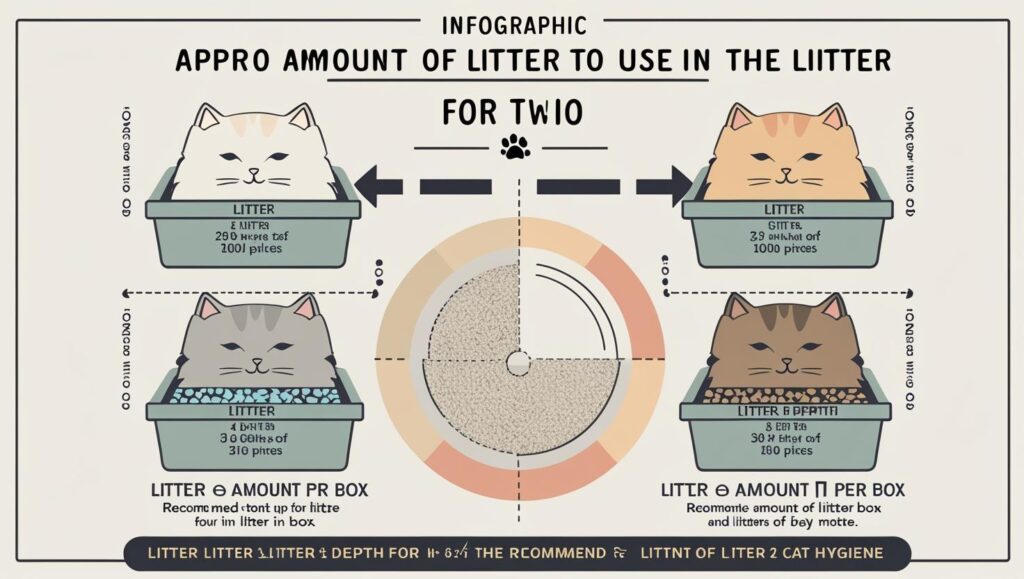
Depth adjustment only goes so far—manage space, too:
Recommendations:
- 3 inches in depth, plus a large or extra-large box
- Or use separate boxes: “2 cats + 1” rule
- Scoop multiple times daily to prevent odour buildup
How Often to Change Cat Litter
Depth means nothing without cleanliness:
By Litter Type:
- Clumping clay: Scoop daily + replace every 2–4 weeks
- Non-clumping: Replace fully every 7 days
- Silica gel: Stir weekly + full change every 30 days
- Biodegradable: Bi-weekly replace, easier for compost use
How Big Should a Litter Box Be?
Depth is one part—box size completes the comfort equation:
Size Recommendations:
- Box ≥ 1.5× your cat’s body length
- High sides (4–6 inches) to prevent scattering
- For seniors, low-entry or covered styles are ideal
Further readings:
How to help your cat(s) use the litter box
Five Litter Box Tips from the Cat’s Point of View
Are You Using Too Much Cat Litter?
How Much Litter Should I Put In The Litter Box?
FAQs – How Deep Should Cat Litter Be
1. How deep should cat litter be for odor control in 2025?
To control ammonia odor effectively, the depth should be 2–3 inches for most cats. A thin layer can’t absorb enough liquid, while overly deep litter traps waste and makes scooping harder. Pair this depth with eco-friendly cat litter or silica gel crystals for modern homes—both have advanced odor-locking properties.
2. Is 2 inches of cat litter enough for clumping performance?
Yes, 2 inches is sufficient for most clumping clay or biodegradable litter. It allows solid clumps to form without sticking to the bottom of the litter box. If you notice the clumps breaking apart, top up 0.5 inches and store extra litter in cat litter storage to keep it fresh and moisture-free.
3. How deep should cat litter be for kittens?
For kittens, the ideal depth is 1–1.5 inches, as deeper litter can overwhelm them and discourage box use. Kittens also require softer, unscented litter because strong fragrances can irritate their sensitive respiratory systems. If training multiple kittens, ensure each box is cleaned daily and log cleaning times in a Cat care planner for consistency.
4. How much litter to put in a litter box for 2 cats?
For two cats, aim for 3 inches of litter depth and follow the “1 box per cat + 1” rule. This prevents territorial disputes and reduces the risk of inappropriate elimination. Consider multi-cat clumping formulas or silica gel to handle the increased urine load. Regular scooping (2–3 times per day) is non-negotiable.
5. Can I use sand instead of kitty litter long term?
While sand is a temporary emergency substitute, it’s not ideal for long-term use. Sand lacks clumping performance and offers zero ammonia odor control. It also requires full replacement every 1–2 days, which becomes costly and unhygienic. Switching to eco-friendly litter alternatives (corn, wheat, or recycled paper) or silica gel crystals is a smarter 2025 choice.
6. What to avoid when choosing cat litter?
Avoid heavily perfumed litters, dusty clay types, and those with harsh chemicals. Respiratory-friendly cat litter, such as low-dust clumping clay or plant-based biodegradable litter, is a safer option for indoor environments. Always store litter in airtight containers like cat litter storage bins to maintain freshness and prevent moisture absorption.
7. How often should I change the litter if the depth is 2–3 inches?
Clumping litter: Scoop daily and top up weekly; do a full replacement every 2–4 weeks.
Silica gel: Stir daily and replace every 30 days.
Biodegradable litter: Replace every 1–2 weeks due to natural breakdown.
Regular cleaning ensures cat comfort, prevents bacterial growth, and eliminates odors. Use a Cat care planner or smartphone reminder to stay consistent.
Wrapping up-How deep should cat litter be
How deep should cat litter be is more than just pouring a random amount—it’s about creating a comfortable, hygienic, and odor-free space that matches your cat’s natural instincts. The right depth (usually 2–3 inches) prevents waste from sticking to the bottom, reduces ammonia build-up, and ensures your cat feels secure while digging and covering.
Test and Adjust Depth: Cats have unique preferences. Start at 2 inches and adjust weekly based on digging behavior.
Consider Box Type & Household Size: A litter box in a multi-cat home should have 3 inches of litter and follow the “1 box per cat + 1” rule.
Choose High-Performance Litter: Modern silica gel crystals, eco-friendly cat litter, and low-dust clumping formulas outperform sand or traditional clay.
Proper Storage: Use sealed cat litter storage bins to keep moisture out and extend litter freshness.
Maintenance Matters: Regular scooping and full replacements keep odor and bacteria under control—track it using a Cat care planner or reminders.Travel Smart: If flying or on the road, know TSA cat litter rules and use disposable or portable solutions.

